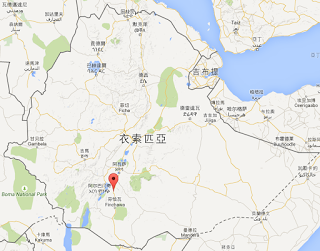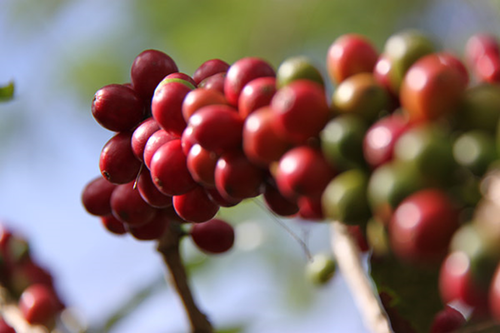The latest coffee treatment method of Yega Xuefei in Ethiopia-- dried fruit on trees and drying in mulch

For professional baristas, please follow the coffee workshop (Wechat official account cafe_style)
What is dried fruit coffee on the tree?
Some farmers deliberately let coffee berries naturally dry "dried on the tree" or "Tree Dry-Process" on trees-coming from beans harvested at a late stage, after the cherry has already dried on the tree. To put it simply, in the sunny season, let the coffee fruit bask in the purple-black dried fruit on the tree, harvest it and then use the general sun treatment. Dried on the tree is common in Yemen and Brazil, and it has recently been found that beans in Bali in Indonesia use this technique of breaking branches without picking, making the coffee sweeter but less bright. At the same time, this will keep the coffee berries on the tree longer without fermenting, but only if the weather temperature is moderate and the coffee fruit (tree) is in shade. It is best not to do this in areas with low elevations and high temperatures, because coffee berries begin to ferment directly on the trees and affect the flavor quality of coffee.
The dried fruit on the tree, literally, is the fruit dried on the tree. When the coffee cherry is naturally dried on the tree, it not only fully absorbs the nutrients of the tree, but also absorbs a lot of sunlight, so the aroma, sweetness and flavor will be richer. However, the relative harvest time is reduced, and more fruit will fall when dried, so it becomes a more expensive boutique coffee. In this way, the dried fruit on the tree is not only sour and sweet, but also bitter and balanced. There will be some bitterness in the aftertaste, but the dried fruit on the tree itself has a unique taste, not only clean, but also great flavor.
What do you do with dried fruit coffee on the tree? What are the characteristics?
In the drying treatment of the tree, this method requires sufficient sun exposure so that the fruit can be evenly dried on the tree, and it must be harvested one by one by hand to ensure that each fruit harvested is dry enough. and can only harvest the fruit from the top of the tree to the middle of the tree, and the fruit below the middle of the tree cannot be used because of the lack of sunshine and the degree of dryness. There will be a lot of fruits that can not be used to be discarded or sold cheaply in fruit trees that are dried in oysters.
After harvest, there is also a scaffolding sun. The moisture and sweetness of these hand-harvested ripe brown fruits are still very uneven. Through the scaffolding sun, their moisture content is more uniform and their sweetness develops more completely.
To friends who often visit coffee shops, Ethiopia's Yirgacheffe is by no means an unfamiliar name, but what does Yega Xuefei mean? Why on earth does he have the charm to always appear on the coffee shop menu? Yega Xuefei is one of the producing areas in Ethiopia, and its geographical environment is a high-altitude wetland (about 1900 meters). It was originally part of the Sidamo producing area. It is popular all over the coffee world because of its classic floral aroma, citrus notes and bright acidity. However, in the case of more and more Yega Xuefei coffee, even the coffee beans in the same producing area will have different flavors because of the different post-processing methods of the factories or cooperatives, so they further classify them into the information that coffee lovers need to know according to the cooperatives. Among them, the most famous cooperatives in Mist Valley are Idido, Beloya and other cooperatives. There are also processing plants such as Chelektu and Konga, who most often wash G1 or G2 coffee and use sun treatment after G3, but in recent years, they have also heard that G1 and G2 coffee have been used for sun treatment, so that the flavor of coffee has more changes and possibilities. (note: Ethiopia's raw coffee beans are graded according to the number of defective beans. G1 represents the least number of defective beans, while G5 is the most and lowest grade.)
In addition, since Ethiopia is considered by most people to be the origin of coffee, there are more than 4, 000 unnamed coffee varieties in Ethiopia, so when buying Ethiopian coffee beans, most of the varieties will be marked as Heirloom. Coffee beans are large and small, and the same batch of coffee beans will contain more than ten coffee varieties. No specific varieties can be summed up as in Central and South America, but in recent years, a great progress has been made by the world-famous raw bean merchant Ninety Plus (or 90+) who began to plan to grow a single variety of Yega Xuefei, also known as VARON (Variety variety + One single). This coffee Alice has been drunk in Coffee Sweet, the flavor is quite clean, but the established impression of flower and citrus is no longer so strong, but into a cup of thick dried coffee fruit tea. With a more spicy flavor. This kind of coffee has its particularity and significance, but whether the price and flavor can be accepted may be another matter.
Ethiopia Yega Xuefei is definitely a classic coffee, even the partners in Yun Studio are infatuated with it, and it tastes good both in hot water brewing and cold ice brewing, and the flavor plasticity is quite high.
Ye Jia Xuefei coffee beans
Introduction of the origin of ◆
Ethiopia is the first country to discover coffee, and it belongs to the most important producing country in terms of coffee quality and output, with an annual production of about 350000 tons. Ethiopia is famous all over the world for its mocha beans in Hara, of which Yirgacheff is located in the south of Sidamo in a narrow area with an altitude of 1700 to 2100 meters above sea level. Arabica coffee beans produced are regarded as the best coffee in Africa. Among the coffee beans, Yejasuefi is one of the best quality coffee in the world and the most expensive coffee in Ethiopia.

(Ethiopia)
◆ level
Ethiopian coffee beans are divided into Grade1~ Grade5 five grades, Grade1 is the highest grade, Grade1 and Grade2 are usually washed beans, others are mostly in the sun area, Grade1 raw beans have about 3 defective beans per 300g, and Grade2 has about 412 defective beans.
◆ cutting environment
It is divided into four types: semi-forest coffee, forest coffee, manor coffee and cultivation field coffee.
Semi-forest coffee: coffee grown in this way does not grow in a completely natural forest. Farmers will adjust the spacing of trees, remove weeds and give coffee trees good sunshine.
Forest coffee: in Ethiopia, coffee harvested by coffee trees growing in the woods is called forest coffee.
Manor coffee: the most typical way to grow coffee is that farmers grow coffee and other crops near their homes, accounting for more than half of the country's output.
Cultivation farm coffee: the output accounts for about 1015% of the country's. Cultivation farm coffee is grown on state-run special farms to increase production.
Characteristics of ◆ coffee beans
Produced in Ethiopia-Yegashev, the raw beans are yellowish green, and the coffee beans produced in this area are small in shape, high in hardness, beautiful and complete in shape, and after shallow roasting, such as the upgraded version of mocha, it is also called perfume coffee, which has the taste of other coffee, fruit aroma and scented tea taste, slightly sour, sweet and soft taste is very suitable for Easterners. Yegashev is famous for its unique taste, which is praised by people who have tasted it. It is a high-quality Arabica bean.
◆ fragrance characteristics
Yega Xuefei can drink bright sour taste, with lemon and citrus fruit and sweetness, light floral aroma and balanced acidity, interpret the taste just right, taste similar to the illusion of tea taste, strong and soft layers, taste from sour to sweet to sweet, making the sour very mild, because the aroma is clear With its unique lemon aroma, honey sweetness and floral aroma, pleasant sweet fruit acidity and multi-layered rich taste, it has become the most unique flavor of coffee and is known as the best coffee bean in Ethiopia. Therefore, it is loved by many people, and it is also referred to as the queen of coffee by the Japanese.
Important Notice :
前街咖啡 FrontStreet Coffee has moved to new addredd:
FrontStreet Coffee Address: 315,Donghua East Road,GuangZhou
Tel:020 38364473
- Prev

A basic introduction to Columbia Coffee Manor: planting situation, Variety characteristics and Flavor Manor Calendar
Colombia Huilan Lerusa Manor Guide: Manor: Colombia Huilan Lerusa Manor Tree species: old Bobang 60%, Tibica 40% altitude: 1550 meters taste: sweet pulp, mellow, depth, excellent sense of balance the manor does not use a high-speed and convenient dryer, but uses the traditional SUN DRY drying method, basic information origin: Colombia Huilan Lerusa Manor
- Next

Would you like some coffee that is not sour and tastes good? Try coffee beans from Papua New Guinea.
Communication of professional baristas Please follow the coffee workshop (Wechat official account cafe_style) Asians do not like sour and hate bitterness, unlike in Europe and the United States. I generally don't like sour. I have no choice but to choose coffee beans with a deep degree of cultivation. However, there is a new producing area of Papua New Guinea, where coffee beans have a rich and solid taste of Mantenin, but the acidity is very low and the flavor is very dry.
Related
- Detailed explanation of Jadeite planting Land in Panamanian Jadeite Manor introduction to the grading system of Jadeite competitive bidding, Red bid, Green bid and Rose Summer
- Story of Coffee planting in Brenka region of Costa Rica Stonehenge Manor anaerobic heavy honey treatment of flavor mouth
- What's on the barrel of Blue Mountain Coffee beans?
- Can American coffee also pull flowers? How to use hot American style to pull out a good-looking pattern?
- Can you make a cold extract with coffee beans? What is the right proportion for cold-extracted coffee formula?
- Indonesian PWN Gold Mandrine Coffee Origin Features Flavor How to Chong? Mandolin coffee is American.
- A brief introduction to the flavor characteristics of Brazilian yellow bourbon coffee beans
- What is the effect of different water quality on the flavor of cold-extracted coffee? What kind of water is best for brewing coffee?
- Why do you think of Rose Summer whenever you mention Panamanian coffee?
- Introduction to the characteristics of authentic blue mountain coffee bean producing areas? What is the CIB Coffee Authority in Jamaica?

